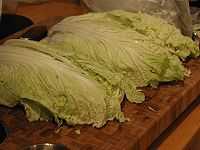Napa cabbage
| Napa cabbage | |||||||||||||||||||
 Some nappa cabbages | |||||||||||||||||||
| Chinese name | |||||||||||||||||||
|---|---|---|---|---|---|---|---|---|---|---|---|---|---|---|---|---|---|---|---|
| Simplified Chinese | 大白菜 | ||||||||||||||||||
| Traditional Chinese | 大白菜 | ||||||||||||||||||
| |||||||||||||||||||
| Cantonese | |||||||||||||||||||
| Chinese | 黃芽白 | ||||||||||||||||||
| |||||||||||||||||||
| Korean name | |||||||||||||||||||
| Hangul | 배추 | ||||||||||||||||||
| |||||||||||||||||||
| Japanese name | |||||||||||||||||||
| Kanji | 白菜 | ||||||||||||||||||
| Hiragana | はくさい | ||||||||||||||||||
| |||||||||||||||||||
| Nutritional value per 100 g (3.5 oz) | |
|---|---|
| Energy | 68 kJ (16 kcal) |
| Carbohydrates | 3.2 g |
| - Dietary fiber | 1.2 g |
| Fat | 0.2 g |
| Protein | 1.2 g |
| Vitamin C | 27 mg (33%) |
| Calcium | 77 mg (8%) |
| Iron | 0.31 mg (2%) |
| Magnesium | 13 mg (4%) |
| Sodium | 9 mg (1%) |
| Percentages are roughly approximated using US recommendations for adults. Source: USDA Nutrient Database | |
Napa or Nappa cabbage (Brassica rapa subsp. pekinensis), also known as celery cabbage, is a type of Chinese cabbage originating near the Beijing region of China, and is widely used in East Asian cuisine. In much of the world, this is the vegetable referred to as "Chinese cabbage". Nappa cabbage is lighter in color than other Chinese cabbages such as bok choy, which is also sometimes called Chinese cabbage. In the United Kingdom, this vegetable is known as "Chinese Leaf", in New Zealand, as "Wong Bok" or "Won bok", and in Australia as "wombok".
The name "nappa" comes from colloquial and regional Japanese, where nappa (菜っ葉) refers to the leaves of any vegetable, especially when used as food.[1] The Japanese name for this specific variety of cabbage is hakusai (白菜), lit. "white vegetable", a Sino-Japanese reading of the Chinese name.
In Korean cuisine, it is the main ingredient of baechu kimchi, the most common type of kimchi, but is also eaten raw as a wrap for pork or oysters, dipped in gochujang. The outer, tougher leaves are used in soups.
Nappa cabbage is widely used in China, Japan, and Korea. Because of immigrants from these nations, it is also readily found in many North American, European and Australian cities.
The flavor has been described by some as delicate compared to bok choy or cabbage, and it can be used in stir-fry with other ingredients such as tofu, mushroom or zucchini. It is also a very common ingredient that is eaten with hot pot.
Nappa cabbage is used as a sign of prosperity in China, and its image often appears as a symbol in glass and porcelain figures. The famous Jadeite Cabbage sculpture of Taiwan's National Palace Museum is a carving of a nappa cabbage variety.
See also
- Witlof
References
- ↑ "Oxford English Dictionary nappa, n.2". Retrieved 2010-10-14.